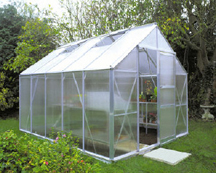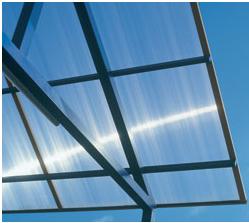Redwood Plastics is the plastics distributor who runs this website and one of our most common inquiries is “Hi, I’m looking for the plastic for a greenhouse…” what ends up happening is an educational process, often via email, whereas the options are narrowed down to really your only option: twin-wall polycarbonate. The most common misconception people have is that regular acrylic or polycarbonate (the smooth stuff) is a good option: it isn’t. For one, you’ll be paying a lot more, but more importantly, the R-Value (heat insulation value) and weathering resistance will be much poorer. Acrylic has decent UV-resistance but regular unmodified polycarbonate has poor weathering including from the sun. Both options will be much more pricey than the twin-wall, which you should have been using in the first place.
Twin-wall polycarbonate has excellent R-values and resistance to UV-light and weathering. The 4′ x 10′ x 6mm profile is what we be considered “standard”. Many customers do specify 8mm or even 10mm thick polycarbonate and we often wonder why. Yes, the R-value would increase; however, you lose light transmission value. So are you really ahead? Certainly you are NOT ahead when it comes to price as 8-10mm thick polycarbonate is much more expensive. We’ve had members of the “DIY” community have excellent results with 6mm thick twin-wall in Saskatchewan where winters can reach -30 degrees Celsius. For more information on the tradeoffs between different polycarbonate thickness options, click here.
The benefits of twin-wall polycarbonate are excellent and they include:
-Ease of fabrication via common woodworking tools. Diamond/carbide-tipped blades not required.
-Relatively low price
-Full UV-stabilization/resistance to weathering
-High light transmission
-A product that is meant to be for greenhouse applications!
For a personal response to your questions on twin-wall polycarbonate, contact Redwood Plastics today.

